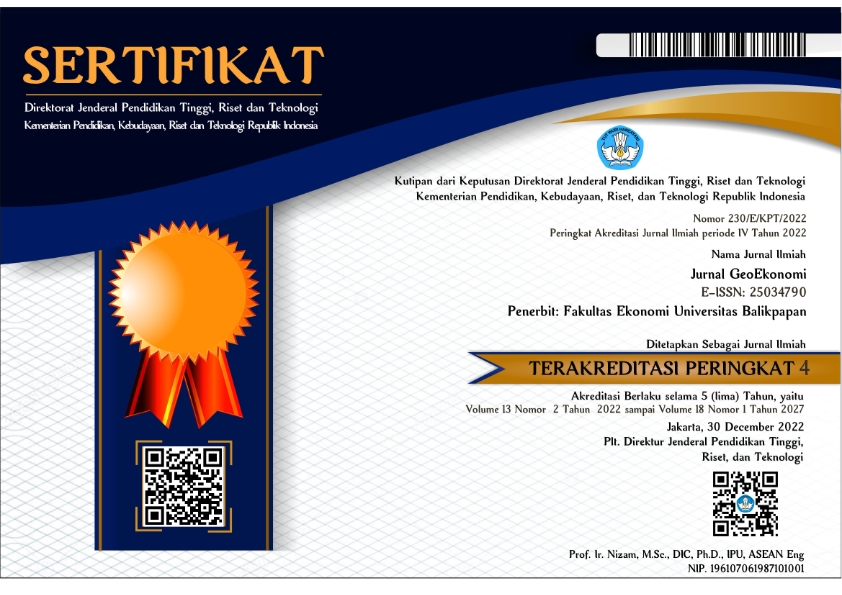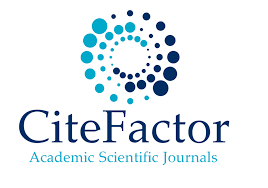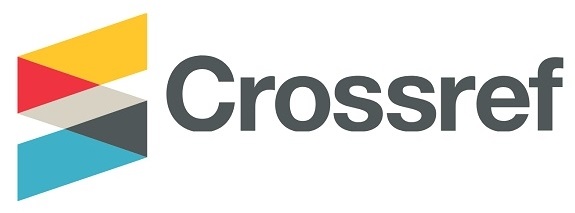Pengaruh Corporate Governance dan Auditor Eksternal dalam Pencegahan Kecurangan Menggunakan Model Beneish dan Model OMI
DOI:
https://doi.org/10.36277/geoekonomi.v14i2.314Keywords:
Fraud, Fraud Prevention, Corporate Governance, External Auditors Quality, Beneish Model, OMI ModelAbstract
Fraud cases have occurred since 2001. This has an impact on the decline in the world economy. In 2019, there was another decline in the world economy due to the Covid-19 outbreak which had an impact on reducing the quality of company financial reports. To prevent a decline in the quality of company financial reports which results in increased fraud, corporate governance and the quality of a company's external auditors must be improved. This study aims to empirically examine the role of corporate governance attributes, consisting of boards of directors, commissioners, audit committees, and institutional ownership, as well as the role of the quality of external auditors which is proxied by differences in Big 4 and Non Big 4 auditors in fraud prevention. The research sample is non-financial companies listed on the Indonesia Stock Exchange (BEI) during the 2017-2021 period, with observations of 307 companies. The regression method used to test the hypothesis is, the Beneish Model uses the logistic regression method with the help of SPSS ver 21 and the OMI Model uses the OLS regression method with the help of Eviews 12. The results of the research between the two regression models are that only the external auditor quality variable has a significant relationship with prevention. fraud. However, when tested using the logistic regression method, the variables that are significant in preventing fraud are institutional ownership and the quality of external auditors. Meanwhile, when tested using the OLS regression method, the research results showed that the variable that was significant in preventing fraud was the quality of the external auditor. So the use of the OMI Model in this research can strengthen the probability results of the Beneish Model to measure fraud in a company.
Downloads
References
Anugerah, R. (2014). PERANAN GOOD CORPORATE GOVERNANCE DALAM PENCEGAHAN FRAUD. Jurnal Akuntansi, 3(1), 101–113.
Bawekes, H. F., Simanjuntak, A. M. A., & Daat, S. C. (2018). Pengujian Teori Fraud Pentagon Terhadap Fraudulent Financial Reporting. Jurnal Akuntansi Dan Keuangan Daerah, 13(1), 114–134.
Beneish, M. D. (1999). The detection of earnings manipulation. Financial Analysts Journal, 55(5), 24–36.
Chen, G., Firth, M., Gao, D. N., & Rui, O. M. (2006). Ownership structure, corporate governance, and fraud: Evidence from China. Journal of Corporate Finance, 12(3), 424–448.
Dechow, P. M., Hutton, A. P., Kim, J. H., & Sloan, R. G. (2012). Detecting earnings management: A new approach. Journal of Accounting Research, 50(2), 275–334.
Dewi, P. P., Suwantari, N. P. E., & Pradhana, I. P. D. (2021). Faktor-Faktor Pencegahan Fraud pada Lembaga Perbankan. E-Jurnal Akuntansi, 31(6), 1592. https://doi.org/10.24843/eja.2021.v31.i06.p19
Dezoort, F. T., Hermanson, D. R., & Houston, R. W. (2008). Audit committee member support for proposed audit adjustments: Preâ€SOX versus postâ€SOX judgments. Auditing: A Journal of Practice & Theory, 1(27), 85–104.
Dwiputri, I. I. (2013). Analisis pengaruh pengungkapan etika dan unsur good corporate governance terhadap kemungkinan kecurangan laporan keuangan (Studi empiris pada perusahaan manufaktur yang terdaftar di Bursa Efek Indonesia). Journal of Accounting, 1(1), 9–16.
Francis, J. R. (2004). What do we know about audit quality? British Accounting Review, 36(4), 345–368. https://doi.org/10.1016/j.bar.2004.09.003
Francis, J. R. (2011). A framework for understanding and researching audit quality. Auditing, 30(2), 125–152. https://doi.org/10.2308/ajpt-50006
Frikha Chaari, H., Belanès, A., & Lajmi, A. (2022). Fraud Risk and Audit Quality: the Case of Us Public Firms. Copernican Journal of Finance & Accounting, 11(1), 29–47. https://doi.org/10.12775/cjfa.2022.002
Gusnardi. (2018). Pengaruh Peran Komite Audit , Pengendalian Internal , Audit Internal Dan Pelaksanaan Tata Kelola. Ekuitas, 15(110), 130–146.
Hambrick, D. C. (2007). Upper echelons theory: An update. In Academy of management review (Vol. 32, Issue 2, pp. 334–343). Academy of Management Briarcliff Manor, NY 10510.
Hasan, M. S., Omar, N., Barnes, P., & Handley-Schachler, M. (2017). A cross-country study on manipulations in financial statements of listed companies Evidence from Asia. Journal of Financial Crime, 24(4), 656–677. https://doi.org/10.1108/JFC-07-2016-0047
Horwarth, C. (2011). The Mind Behind the Fraudsters Crime: Key Behavioral and Environmental Element, USA: Crowe Horwarth International.
Hsu, Y. L., & Yang, Y. C. (2022). Corporate governance and financial reporting quality during the COVID-19 pandemic. Finance Research Letters, 47(PB), 102778. https://doi.org/10.1016/j.frl.2022.102778
Irawati, L., & Fakhruddin, I. (2016). Pengaruh dan Kualitas Audit Corporate Governance terhadap Integritas Laporan Keuangan. Kompartemen: Jurnal Ilmiah Akuntansi, 14(1).
Jacob, J., Desai, N., & Agarwalla, S. K. (2019). An examination of factors driving big 4 audit fee premiums: Evidence from India’s audit market. Accounting Horizons, 33(2), 43–58.
Jensen, M. C., & Meckling, W. H. (1976). Theory of the firm: Managerial behavior, agency costs and ownership structure. Journal of Financial Economics, 3(4), 305–360.
Susilowati, D., Nurlia, N., & Juwari, J. (2022). Good Corporate Governance Characteristic, Profitability and Firm Value: Evidence from Indonesia. IQTISHODUNA, 18(2), 99-121.
Klein, K. (2017). Does Gender Diversity on Boards Really Boost Company Performance? A Business Journal from the Wharton School of the University of Pennsylvania. https://knowledge.wharton.upenn.edu/article/will-gender-diversity-boards-really-boost-company-performance/
Komala, L., & Asaari, M. (2022). Analisis peran satuan pengawasan internal dan komite audit terhadap pencegahan kecurangan. Fair Value: Jurnal Ilmiah Akuntansi Dan Keuangan, 4(12), 5850–5857. https://doi.org/10.32670/fairvalue.v4i12.2215
Koroy, T. R. (2008). Pendeteksian Kecurangan (Fraud) Laporan Keuangan oleh Auditor Eksternal. Jurnal Akuntansi Dan Keuangan, 10, 22–23. https://doi.org/10.9744/jak.10.1.PP. 22-23
Lajmi, A., Khiari, W., & Ouertani, O. (2021). Legal Audit Quality and Fraud Risk: the Case of Tunisian Listed Companies. International Journal of Accounting & Finance Review, 6(2), 1–15. https://doi.org/10.46281/ijafr.v6i2.1039
Lennox, C. (1999). Are large auditors more accurate than small auditors? Accounting and Business Research, 29(3), 217–227.
Mangala, D., & Kumari, P. (2015). Corporate Fraud Prevention and Detection: Revisiting the Literature. Journal of Commerce and Accounting Research, 4(1). https://doi.org/10.21863/jcar/2015.4.1.006
Murtado, A., Andru, A., Darmayanti, A., & Adriadi, K. (2022). Detecting fraud of financial statement through pentagon’s fraud theory. Jurnal Inovasi Ekonomi, 7(01), 39–46. https://doi.org/10.22219/jiko.v7i01.18721
Natonis, S. A. (2019). CEO Behavioral Influences Firm Performance : A Study Literature Pengaruh Aspek Keperilakukan CEO terhadap Kinerja Perusahaan : Sebuah Studi Literatur. 3, 250–259.
Nugroho, D. S., & Diyanty, V. (2022). Fraud Hexagon and Fraudulent Financial Statement: Comparison Between OMI and Beneish Model. Proceedings of the International Conference on Economics, Management and Accounting (ICEMAC 2021), 207(Icemac 2021), 1–10. https://doi.org/10.2991/aebmr.k.220204.001
Panda, B., & Leepsa, N. M. (2017). Agency theory: Review of theory and evidence on problems and perspectives. Indian Journal of Corporate Governance, 10(1), 74–95.
Prasetyo, A. B. (2014). Pengaruh Karakteristik Komite Audit Dan Perusahaan Terhadap Kecurangan Pelaporan Keuangan. Jurnal Akuntansi & Auditing, 11(1), 1–24.
Salleh, S. M., & Othman, R. (2016). Board of Director’s Attributes as Deterrence to Corporate Fraud. Procedia Economics and Finance, 35(16), 82–91. https://doi.org/10.1016/s2212-5671(16)00012-5
Santosa, S., & Ginting, J. (2019). Evaluasi Keakuratan Model Beneish M-Score Sebagai Alat Deteksi Kecurangan Laporan Keuangan (Kasus Perusahaan Pada Otoritas Jasa Keuangan di Indonesia). Majalah Ilmiah Bijak, 16(2), 75–84. https://doi.org/10.31334/bijak.v16i2.508
Sari, E. G. (2022). Fraud Risk Analysis Fraud Prevention Detection with Fraud Triangle and Financial Ratios at PT. Garuda Indonesia (Persero) Tbk. Asia Pacific Fraud Journal, 7(2), 225. https://doi.org/10.21532/apfjournal.v7i2.269
Septriani, Y., & Handayani, D. (2018). Mendeteksi Kecurangan Laporan Keuangan dengan Analisis Fraud Pentagon. Jurnal Akuntansi Keuangan Dan Bisnis, 11(1), 11–23.
Sukamulja, S. (2005). GOOD CORPORATE GOVERNANCE DI SEKTOR KEUANGAN: DAMPAK GCG TERHADAP KINERJA PERUSAHAAN (Kasus di Bursa Efek Jakarta). Good Corporate Governance … (Sukmawati Sukamulja, 1–25. www.fcgi.
Suparlan. (2019). Analisis Pengaruh Kepemilikan Institusional Dan Kepemilikan Manajerial Terhadap Nilai Perusahaan Dengan Proporsi Dewan Komisaris Independen Sebagai Variabel Moderating (Studi Empiris Pada Perusahaan Sektor Industri Barang Konsumsi Yang Terdaftar Di Bursa. Jurnal Akuntansi Dan Keuangan Syariah - ALIANSI, 2(1), 57–74. https://doi.org/10.54712/aliansi.v2i1.46
Tessa, C. (2016). Fraudulent Financial Reporting: Pengujian Teori Fraud Pentagon Pada Sektor Keuangan Dan Perbankan Di Indonesia. Jurnal Akuntansi, 1–20.
Trijayanti, I., Hendri, N., & Sari, G. P. (2021). Pengaruh Komite Audit, Audit Internal, Dan Whistleblowing System Terhadap Pencegahan Fraud. Business and Economics Conference in Utilization of Modern Technology, 30–42.
Vousinas, G. L. (2019). Advancing theory of fraud: the SCORE model. Journal of Financial Crime.
Wijaya, H. (2022). Diversitas Gender Pada Dewan Dan Kinerja Perusahaan. Jurnal Riset Akuntansi Dan Keuangan, 10(3), 427–436. https://doi.org/10.17509/jrak.v10i3.44558
Wolfe, D. T., & Hermanson, D. R. (2004). The fraud diamond: Considering the four elements of fraud.
Yendrawati, R. (2015). Pengaruh Dewan Komisaris Independen, Komite Audit, Kepemilikan Manajerial, dan Kepemilikan Institusional terhadap Manajemen Laba. Jurnal Entrepreneur Dan Entrepreneurship, 4(1–2), 33–40.
Zager, L., Malis, S. S., & Novak, A. (2016). The Role and Responsibility of Auditors in Prevention and Detection of Fraudulent Financial Reporting. Procedia Economics and Finance, 39(November 2015), 693–700. https://doi.org/10.1016/s2212-5671(16)30291-x
Downloads
Published
How to Cite
Issue
Section
License
Copyright (c) 2023 Jurnal GeoEkonomi

This work is licensed under a Creative Commons Attribution 4.0 International License.








_geoekonomi.png)
_geoekonomi.png)
















